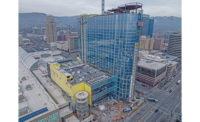Bringing More Arts and Culture to Salt Lake City






Salt Lake City has begun several projects aimed at improving "livability and sustainability," according to two-term Mayor Ralph Becker. The new projects are in addition to the city's recently completed public safety building and the $1.8-billion replacement of terminals at its international airport, already under way.
Dust from building the City Creek mixed-use development had barely settled when across Main Street work on Salt Lake's new Broadway-style performing arts theater began. Farther west, near the Jordan River, the city has started construction of an expansive sports complex of 16 competition-level soccer fields. To the north, a new library and residential-retail development will breathe life into a long underused and neglected area of the city.
Becker says the projects have been planned for years. Financing ranges from voter-approved bonds, redevelopment agency monies and the city's general fund.
"I'm a great believer that we need to include the public in all our decisions, and that has its advantages and disadvantages when it comes to getting things done," Becker says. "You can get endless public input, and some people won't be happy with any decision you make. Some people don't want things to change at all."
Becker says that planning for public projects has to take the long view because these facilities "will serve the community for decades to come."
Public engagement can also mean that projects undergo major changes or are stopped altogether by legal challenges. But such challenges, while sometimes frustrating for city officials, can result in better projects, Becker says.
The use of construction manager-general contractor contracts and the hiring of a CM on larger projects have helped the city contain costs and keep projects on schedule. "Since I came into office, we've overhauled how we take on big projects," Becker says. "We've supplemented our expertise by partnering with outside experts. It makes sense because doing big projects is not something we do often, and it is not our core business."
Broadway Comes to Salt Lake City
The city's success in using a CM-GC contract for the public safety building, with Okland Construction as contractor and Boston-based MOCA Systems Inc. as CM, has led to a similar partnership on the Utah Performing Arts Center project downtown. Layton Construction, Sandy, Utah, holds the CM-GC-at-risk contract. The city is partnering with Dallas-based Garfield Traub to develop the project, and MOCA Systems again serves as CM representative for the Redevelopment Agency of Salt Lake City (RDA).
The 184,000-sq-ft, 2,500-seat facility is intended to enliven downtown and entice national touring shows. The five-story building includes a café and a black box theater. HKS Architects and Pelli Clarke Pelli Architects, both of New York City, designed the center.
Becker proposed the idea of a new performing arts theater in 2008, but it took several years for city leaders to convince other performing arts groups that the facility would not detract from their offerings and would be a net benefit to the area's cultural life. It also took a partnership with Salt Lake County to secure funding to cover the projects' $116 million cost.
The block between Main and State streets to the east of the theater is bisected by an alley known as Regent Street, with entrances on both streets and streetscape enhancements on either side. The entrances will open to a multi-level atrium that designers are calling the Winter Garden.
"It is a continuing partnership with a lot of people coming together with the same goals," says Jeff Beecher, executive vice president at Layton Construction. "There has been good collaboration with the RDA. The developer and architects have done theaters before, and we've done theaters before, and we're bringing all our experience to this."
Beecher says the project requires coordination not only with the design and development team but also with City Creek Reserve Inc., developer of the mixed-use City Creek Center, which is under way just to the north. Upper floors of the planned office tower, to be called 111 Main, will actually overhang the theater building—a design feature not uncommon in larger cities but a first for Salt Lake City.
Sitework for the theater is under way with demolition of several buildings and early excavation of the tight downtown site.
Soccer Complex
In 2003, voters passed a $15.4-million bond to build a complex of soccer fields outside the city center. Salt Lake City-based landscape architect MGB+A The Grassli Group produced a master plan in 2006 for a phased development that includes 16 competition-level fields and amenities on 160 acres adjacent to the Jordan River in the city's northwest quadrant.




